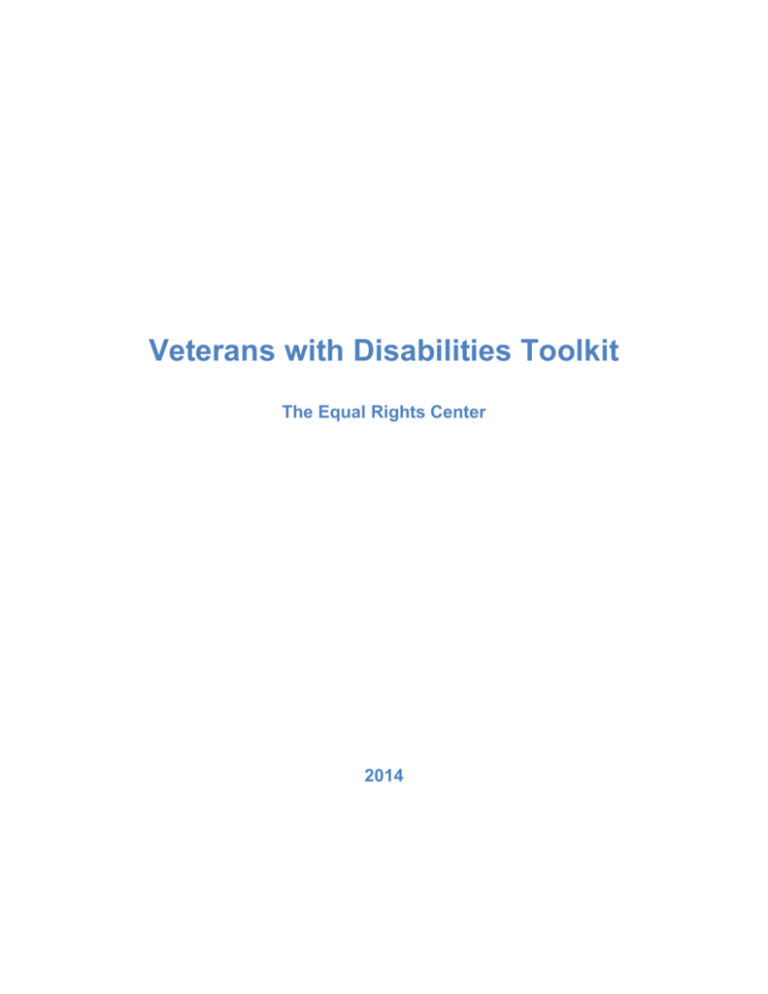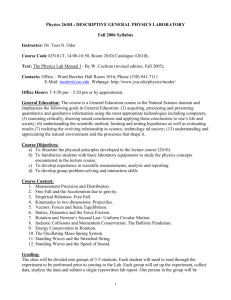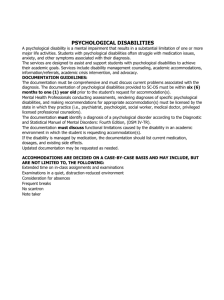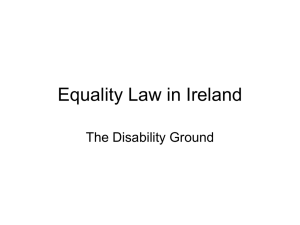Read an accessible version of the Veterans with Disabilites Toolkit
advertisement

Veterans with Disabilities Toolkit The Equal Rights Center 2014 I. Introduction If you are one of the more than half a million veterans who have experienced burns, amputations, traumatic brain injury, paralysis, post-traumatic stress disorder, depression or any other condition that substantially limits your life activities, you have the right to housing that suits your needs. The federal Fair Housing Act protects the rights of veterans with disabilities who are seeking equal access to housing. Under the Fair Housing Act, a disability is defined as a physical or mental impairment that substantially limits a major life activity such as: seeing, hearing, working, and/or the operation of major bodily functions. This toolkit is designed to help you understand your rights under the Fair Housing Act as a veteran with a disability. State and local fair housing and civil rights laws in your area may provide further protections. II. Prohibited Acts The Fair Housing Act (FHA) is comprised of Title VIII of the Civil Rights Act of 1968 and the Fair Housing Amendments Act of 1988. The FHA mandates that any individual or entity involved in the sale and/or rental of housing not engage in discriminatory practices or policies, and treat all potential buyers or renters equally and with respect. If you are a veteran with a disability, you are protected from many types of housing discrimination, including: • • • • • • • The refusal to sell or rent a property; Higher cost or other different terms and conditions; Discriminatory advertising; Misrepresentation of available of units; Blockbusting or steering (directing someone toward or away from a particular neighborhood or section of a building); Harassment, threats, intimidation, and/or coercion; and Retaliation for reporting discrimination or other lawful activity The FHA also requires that housing providers take proactive measures to ensure that veterans with disabilities have equal opportunity to use and enjoy the dwelling. As such, the FHA requires that newly built multifamily dwellings be designed and constructed in accordance with guidelines that minimize physical barriers. In addition, housing providers must provide reasonable modifications and accommodations to veterans with disabilities. III. Accessible Design Newly built multifamily complexes must be designed and constructed to meet a minimal level of structural accessibility. Regulations in the Fair Housing Act impose specific accessible design requirements that minimize the extent of physical barriers for veterans with disabilities. These regulations apply to dwellings with four or more residential units—such as apartment complexes, condominiums, cooperatives, and assisted living facilities—that were completed for first occupancy after March 13, 1991. In buildings that meet these criteria and have an elevator, all units must meet minimum standards for accessibility. In buildings without an elevator, only ground floor units are required to meet the accessibility standards. To meet the accessible design requirements, a multifamily housing complex must have the following seven features: (1) accessible common and public areas; (2) an accessible entrance on an accessible route; (3) usable doors; (4) accessible routes within units; (5) accessible light switches, electrical outlets, and environmental controls; (6) reinforced walls in bathrooms; and (7) useable kitchens and bathrooms. Accessible common and public areas The FHA requires that areas made available to residents, guests, and the general public be on flat or gently sloped routes wide enough to accommodate assistive mobility devices, and have other features to ensure equal access to people with disabilities. Common and public use areas include—but are not limited to—parking lots, sidewalks, lobbies, rental offices, bathrooms, mailboxes and recreation areas. An accessible entrance on an accessible route An accessible entrance on an accessible route allows a person who uses a mobility assistive device, such as a wheelchair, cane, walker or crutches, to get into a building without structural barriers, such as stairs, steep ramps or heavy doors. Accessible entrances provide a continuous path to travel from public transit stops, accessible parking, public sidewalks, and to the property’s amenities, including mailboxes, garbage areas, swimming pools and clubhouses. An accessible route should be at least 36” wide and have no structural barriers such as steps, uneven paths, or steep ramps. Useable doors There must be accessible doors into and throughout all common and public areas and leading into units. Accessible doors for public and common use areas must have a clear opening of 32”, and accessible doors in living units must be at least 31 5/8” wide, with thresholds that are less than ¼” high or are appropriately beveled or ramped. All door handles must be operable without tight grasping or twisting. Accessible route within units The exterior doors on an accessible route must be at least 32” wide, and the route must be unobstructed and wide enough for a wheelchair to pass through the main entry door; continue through all rooms in the unit; adjoin clear floor spaces required for appliances; and connect with all secondary exterior doors, such as patio doors. Accessible light switches, electrical outlets, and environmental controls The controls of thermostats and other environmental controls, light switches and electrical outlets in a unit may be no higher than 48” from the floor and no lower than 15” above the floor. This ensures that controls are within reach for people with mobility disabilities. Reinforced walls in bathrooms Veterans with disabilities may need to install grab bars for their toilets and/or bathtubs in their bathrooms. While units are not required to have grab bars, they are required by the FHA to have bathroom walls reinforced so that grab bars may be easily installed. A veteran with a disability may be required to pay for the cost of installing grab bars, but the housing provider must be able to confirm that the walls are reinforced for grab bars. Useable kitchens & bathrooms Usable bathrooms must have clear floor space for a person with a wheelchair to enter, close the door, use the toilet, sink and bath, reopen the door, and exit. Usable kitchens must have sufficient space for a person who uses a wheelchair to maneuver about the kitchen and have sufficient clear floor space in front of appliances. 1. There should be enough room for a person in a wheelchair to pull sideways to access the sink or stove. A person should be able to set a dish in the sink or a pot on the stove with ease. 2. The dishwasher and the refrigerator must have enough clear floor space so a person facing it can pull forward or sideways to access an item. 3. There must be 40” of clearance between all opposing walls and appliances, even if an appliance protrudes farther than the counter. 4. In “U-shaped” kitchens, in which there is a sink, range, or cooktop at the base of the “U,” there must be a 60” circle for a wheelchair to turn around. IV. Reasonable Accommodations and Modifications In addition to ensuring structural accessibility, the Fair Housing Act, as amended in 1988, requires property owners to allow reasonable modifications and reasonable accommodations to the property upon request by an individual with a disability. A modification is generally a structural change to an area, such as adding a ramp or removing cabinets, and the cost of making the modification may fall on the person making the request. An accommodation is generally a change in rule or policy, such as having an assistance animal in a no pets building. If you are a veteran with a disability, you are entitled to a reasonable modification or a reasonable accommodation to your dwelling if it is necessary for your use of the premises. In order for a requested modification or accommodation to be considered reasonable, (1) there must be an identifiable relationship between the requested accommodation and the individual’s disability, and (2) the request must not impose an undue financial or administrative burden on the housing provider. Whether or not an accommodation poses an undue financial or administrative hardship on the landlord depends on the overall cost of the accommodation and the resources of the landlord and will vary on a case-by-case basis. When requesting an accommodation or modification, you may need to provide third party verification which supports your request. Such documentation can be provided through various sources which include, but are not limited to, doctors, nurses, caseworkers, or advocates. This documentation should confirm that you have a disability and that the reasonable modification or accommodation is needed because of your disability; however, it does not need to include diagnosis, treatment, or other detailed medical information. Frequently Asked Questions How do I determine when a multifamily complex was completed for first occupancy, and therefore must meet the accessible design requirements? To determine the date of first occupancy of a building, look for a government issued Certificate of Occupancy. It should be prominently posted and visible to a person visiting the building. What are examples of reasonable modifications that may be needed for veterans who have acquired disabilities? 1. If the bathrooms in a unit are inaccessible, a person with diminished lower body strength limited mobility may request for grab bars to be installed in the shower or around the toilet. 2. If the entrance to a housing complex has stairs, an amputee in a wheelchair may request for a ramp to be installed for improved access through a doorway or to a specific facility, such as the leasing office or laundry room. 3. If a housing unit has cabinets under the kitchen sink which prohibit a wheelchair user to fully use the sinks or countertops, the tenant may ask for the cabinets to be removed. What are examples of reasonable accommodations? 1. If a property has limited parking with no assigned spots, a veteran with limited mobility may request an assigned accessible parking space in front of the accessible entrance, or close to his or her unit. 2. If a housing provider has a “no pets” policy in their apartment complex, but a veteran with PTSD has an assistance animal, the housing provider must make an exception to policy to allow the animal at no additional cost. Who is responsible for the cost of a reasonable modification or reasonable accommodation? The tenant is responsible for the cost of a reasonable modification. However, if the modification is in a common area, the landlord is responsible for general upkeep. A landlord may also require a tenant to remove a modification and return a unit to its original condition when the tenant moves out. For reasonable accommodations, the landlord is responsible for any resulting cost. For example, if providing a tenant in a wheelchair with an assigned accessible parking spot requires painting or signage, the landlord is responsible for those costs. Likewise, a housing provider cannot charge a pet deposit or fee for an assistance animal, even if that cost is imposed on residents without disabilities who choose to keep a pet in the building. Do I need to use a specific form to request a reasonable accommodation or modification? No. Once a property manager has been put on notice that an accommodation or modification is needed, they should make every effort to provide it. It is a good idea to make any request in writing and to request a written response so that you have a record of it, but even a verbal request must be granted if it is reasonable and necessary based on a disability. Can I refuse to provide details about my condition and still have my request for a reasonable accommodation or modification request granted? A property manager can inquire about your condition, but only as much as is necessary to evaluate the nexus between the disability and the accommodation being requested. It is never necessary to divulge the details about your health. What kinds of animals are considered reasonable accommodations in housing? An animal that provides assistance to a person with disability by ameliorating at least one of the conditions of the disability is considered an assistive animal under the Fair Housing Act. Assistive animals can be fully trained service dogs, emotional support animals, and other small animals that have been trained to perform tasks. Emotional support animals that provide comfort, companionship, and stress relief to individuals with severe depression and anxiety are also permitted assistive animals. Assistive animals are not required to have special tags, licenses, or certification. What do I do if I have not been able to get a reasonable accommodation or modification, or am trying to rent an apartment in a building that is inaccessible? There are eight steps you can take to protect your rights. 1. Identify the problem – Clearly identify what barrier(s) exists that prevents you from fully enjoying your home. In order to assist with the identification of the issue, you may want to take pictures of any physical barriers, make a written description, or obtain a copy of any policies from the housing provider concerning the things that you need changed. It is important to remember to make your request clear and specific. 2. Consider the solutions – What do you need in order to make your living environment accessible? Do you need an accessible parking space close to the entrance to the building? Do the cabinets under the sinks need to be removed to allow wheelchair clearance underneath? Have specific details for your proposed solutions. When someone asks you, “What do you want me to do about it?” have an answer for them. 3. Understand your legal rights! 4. Determine who should receive your request – You may send your request via email or through the post office. The request for a reasonable accommodation or modification should be sent to the appropriate housing authority, property manager, or administrative office. You may want to ask the leasing agent where you should send the request, or if there are any specific forms that are normally completed for a request. Do not be alarmed if the leasing agent asks you questions regarding your request. You should be open about the specifics of what you need, but do not need to answer any questions concerning the origin of your disability. You may also refer them to your written request. Remember to always keep a copy of your request. 5. Be persistent – In your initial written contact, make sure that you include a date by which you expect a response. If you do not hear back from the person whom you originally contacted, try following up with a phone call. If the housing provider continues to refuse to speak to you, then you may eventually have to involve a third party such as the ERC. 6. Be polite but firm – Although you may feel anger or frustration with people who do not understand your request, it is extremely important that you stay calm. 7. Keep all documentation – This really does mean ALL documentation however trivial it may seem at the time. If your request is denied or ignored, and you enlist the help of a third party agency like the ERC, the agency receiving your complaint will need as much information as you can give them. Every piece of correspondence between you and the housing provider—business cards, tickets, receipts, records of phone conversations, etc. — should be kept either in a file or a small box in which you can store everything. 8. Know when it is time to get outside assistance – If you cannot reach a resolution with the property owners, call the ERC and we will listen, advise, and help you protect your civil rights. Where can I go for more assistance? File a Complaint If you wish to file a complaint with a government agency on your own, then you should contact one of the agencies listed below. U.S. Department of Housing and Urban Development Complaints of housing discrimination may also be directed to the U.S. Department of Housing and Urban Development (HUD). To initiate a complaint you can complete a form online at www.hud.gov/complaint, or send a letter to your nearest HUD office including: Your name and address; The name and address of the person your complaint is against (the respondent) The address or other identification to the housing involved; A short description of the alleged violation (the event that caused you to believe your rights were violated); The date(s) of the alleged violation; and Other information that you believe necessary to support your complaint. Please send copies of relevant documents. Keep original documents, do not send them. HUD is organized into 10 regions. If you live in the Washington, D.C., Maryland or Virginia area, you can send the letter to the address below. Otherwise, consult HUD’s website to find your region’s nearest office. U.S. Department of Housing and Urban Development The Wanamaker Building 100 Penn Square East, 12th Floor Philadelphia, PA 19107-3380 (215) 861-7646 1-888-799-2085 TTY (215) 656-3450 Contact the ERC If your request for an accommodation or modification goes unanswered or is denied, contact the ERC for assistance at: The Equal Rights Center 11 Dupont Circle N.W., Suite 450 Washington, D.C. 20036 (202) 234-3062 (Voice) (866) 719-4372 (Toll Free) (202) 234-7590 (TTY) (202) 234-3106 (Fax) www.equalrightscenter.org complaints@equalrightscenter.org National Coalition for Homeless Veterans 333 ½ Pennsylvania Avenue SE Washington, DC 20003-1148 (202) 546-1969 (Voice) (800) VET-HELP (Toll Free) (202) 546-2063 (Fax) (888) 233-8582 (Toll Free Fax) www.nchv.org info@nchv.org The American Legion (National Office) Homeless Veterans Taskforce 700 N. Pennsylvania St. P.O. Box 1055 Indianapolis, IN 46206 (317) 630-1200 (Voice) (317) 630-1223 (Fax) www.legion.org/homelessveterans/outreach Volunteers of America National Office 1660 Duke Street Alexandria, VA 22314 (800) 899-0089 (Toll Free Voice) (703) 341-5000 (Voice) (703) 341-7000 (Fax) www.voa.org *The work that provided the basis for this publication was supported by funding under a grant with the U.S. Department of Housing and Urban Development. The substance and findings of the work are dedicated to the public. The author and publisher are solely responsible for the accuracy of the statements and interpretations contained in this publication. Such interpretations do not necessarily reflect the views of the Federal Government.*







